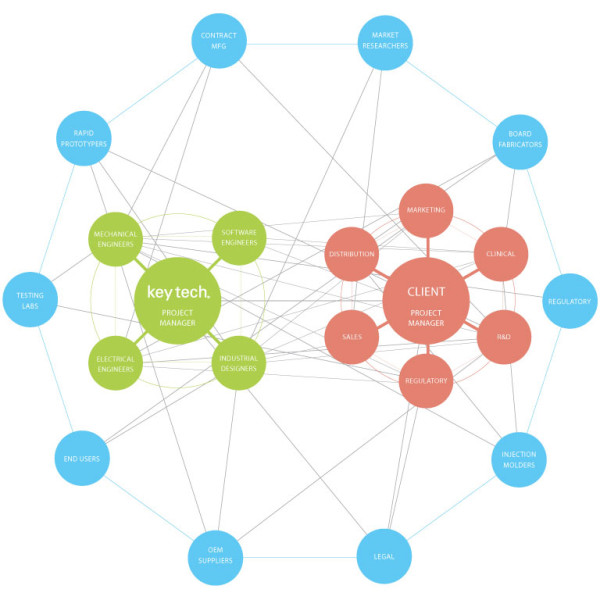
12 Aug Managing Multiple Partners on a Medical Device Design Project
Have you ever worked on a project team that just couldn’t seem to get out of its own way? Where the members were all bright, well-meaning, and highly trained, but the communication was just constantly breaking down, if there was any communication at all?
So many people have been there. We hear from them all the time. Complex design projects bring special communication challenges that can make good teamwork hard to achieve. And the path can get even rockier on projects that involve multiple partners (which most do).
That’s why it’s crucial for project managers (PMs) to develop a solid communication plan and hold all parties to it.
Complicated projects, even those with many partners, need not be a mess. As someone who has managed many projects, here are some best practices at Key Tech for keeping everyone on the same page.
Assembling the Team

For example, we may need to bring in a partner to do front-end market research to help sharpen the business case for the client’s proposed device. Or we might bring in a partner to design simple, high-volume, single-use parts, such as an injection-molded piece of plastic that would hold a patient’s blood or tissue sample.
Once you understand the basic architecture of the device and its components, you may need to find a contract manufacturer. It’s important to research their experience and its compatibility with the device that you’re designing. Ultimately, the client hires the manufacturer, and you want to make sure it’s the best fit for the product we’re designing.
Setting Up the Communications Plan
Now that your multi-party team is assembled, it’s important to set up a communication plan. Depending on client preference, the lead contractor (typically Key Tech) can serve as the conduit through which most communication flows, or all partners can report directly to the client manager.
The PM should set up a schedule of status updates and meetings, and make sure all parties understand and commit to that schedule. All partners should submit a weekly report to the PM, indicating whether they are on schedule, what they have accomplished that week, and what they need to do.
Unofficially, we’re on the phone with our clients almost every day, sometimes four or five times a day. I think it’s important that communication between the lead contractor and the client go beyond the PM in order to prevent bottlenecks. Anyone on the team should be empowered to contact the client as needed to resolve an issue quickly.
Communication Platforms
In addition to the usual email, phone calls and meetings, some clients like all parties to use an online collaboration tool. At Key Tech, we’ve been using Basecamp, Confluence, and Trello. These online tools allow each team member to contribute information and comment upon one other’s posts in real time. They also allow project managers to post action items for each team member and maintain a history of conversations.
These tools can help to reduce the deluge of email that multi-partner projects often generate. They do have a learning curve, but once everyone on a project is using them correctly, they save a lot of time and confusion.
However, collaboration software can turn into a time waster, enticing partners to post about every detail. So the project manager should warn the team up-front about this, and follow up if it becomes a problem.
In addition to the aforementioned communication tools, we have weekly status calls and formal and informal design reviews at least once a month during active design phases. These provide pauses for everyone to scrutinize the design and catch problems early.
Running any multi-partner project involves diplomacy. Project managers must keep everyone communicating, and make sure all parties understand the common goal. All partners must demonstrate patience, goodwill, and a commitment to excellence. For a deeper conversation about best practices for managing complex processes, feel free to reach out.
- Designing a COVID-19 Cartridge and Test Platform - February 24, 2021
- Quick Thinking: Hyper-Rapid Prototyping - May 26, 2020
- Best-In-Class Integration of Design and Manufacturing - May 14, 2020

